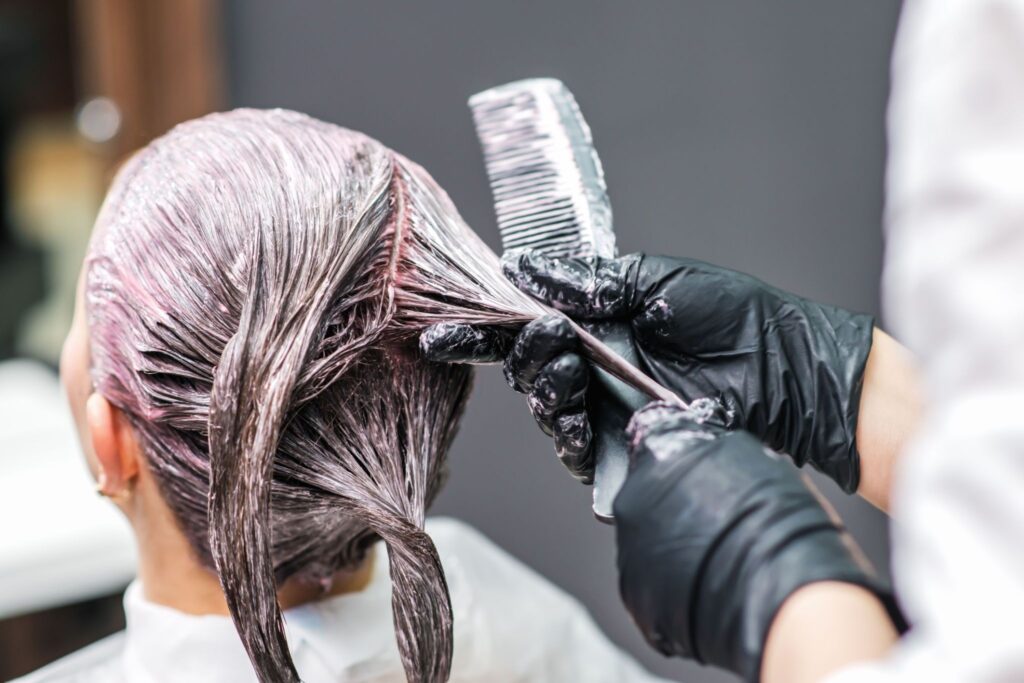Table Of Content

Use a tinted dry shampoo to preserve the temporary color for an extra day or two. Also, consider Living Proof’s Restore Instant Protection to prime hair and prevent damage. Finally, Kevin Murphy’s Young Again Oil benefits all hair types. Consult your stylist for the ideal protectant for your hair’s porosity and texture. Coloring can really dry hair out, so nourish those strands with a rejuvenating deep conditioner every week, girl.

Coloring Sprays
You can’t wash out permanent hair color, and it never totally leaves your hair, but it does fade over time and requires touch-ups to maintain. It can last up to four to six weeks before you need a root touch-up because of hair regrowth or gray hairs that begin showing. As a general rule, you can safely dye your hair every four to six weeks, but how often you should dye your hair depends on a few factors and personal preferences. Most importantly, let your hair health guide how often you should go in for a coloring treatment. If your locks aren’t worse for wear, stick to the recommended timeline.
Importance of Color-Safe Products
Adding thermal insult to chemical injury is a recipe for hair disaster. While a rinse-off conditioner is non-negotiable, a deep conditioner, like Function of Beauty’s custom hair mask, offers an extra dose of nourishment. All you have to do is pick your favorite hair goals (color protection included) to bestow an optimal blend of nutrients on dry, damaged, or dull-looking hair.
How Often Can You Dye Your Hair With Permanent Hair Color?
If you don’t take care of your colored hair, you may find yourself in a never-ending cycle of damage and repair. Here are a few ways you can determine how long you can go in between colorings. A color gloss treatment keeps your locks looking shiny and vibrant between dyes by adding an extra layer of protection for longer-lasting results. Natural dyes like henna or indigo offer a gentler approach to coloring but may require more effort for results.
If you have black or brown hair and are coloring your mane a shade of blonde, you’ll likely be damaging your strands more than if you were to stay one to two shades within your starting color. More specifically, if bleach is used to color your hair and achieve a lighter shade, you’ll want to put more space in-between your coloring sessions. Whether you’re dissatisfied or simply bored with your current look, changing your hair color is a great way to mix things up and feel renewed.
This means you should limit how often you dye your hair to avoid issues like hair loss or baldness. The color typically lasts for 20 to 28 washes, making it a good option for those who want something more permanent without the damage. In this article, we’ll take a closer look at what these are, and discuss expert-approved tips for keeping your hair strong and healthy at every stage. Changing your hair color can be a great way to enhance your appearance and express your style. Color-safe shampoos are shampoos that are specifically designed to be used on color-treated hair, so hair does not become dull or stripped of the color. These also don't contain ammonia or fully penetrate the hair's cuticle.
Hair dye cons
You invested a lot in getting a new look, so don’t wash that color down the drain. Opt for sulfate-free hair care products that are formulated for color-treated hair, like the L’Oréal Paris EverPure Repair & Defense Shampoo and L’Oréal Paris EverPure Repair & Defense Conditioner. Follow up by applying the conditioner and leaving it on for 1-3 minutes. But if the change you want to make is simple and you’re interested in DIY dyeing, picking the right coloring kit is key. Consider your natural hair color, the health of your hair, and the type of color you’re using when making your decision.
Tips to extend the life of your hair color
There’s also some evidence that certain components of permanent dye could be harmful to your health. Many of the problem chemicals were removed from dye formulas in the 1970s, but there isn’t much recent research to determine if existing chemicals are safe. When roots become visible, typically four to six weeks post-coloring, follow the root touch-up application instructions to maintain an even color result from month to month. The right hair color can update any hairstyle and brighten any complexion. Knowing how often you can safely color your hair helps prevent damage.
Ramiriez says that clients that are almost entirely gray typically like to have their hair touched-up every two weeks with a high-coverage, permanent hair color such as the Redken Cover Fusion. “If they only have a few grays to blend, then I like to use a Shades EQ shade that is as close to their natural color as possible,” he says. This will allow you to stretch your color closer to the six-to-eight-week mark. How porous your hair is will have an effect on how vibrant your permanent or semi-permanent dye will look and last. As a general rule, permanent colors may fade but will have to be grown-out or dyed over if you want to change them.
Start by parting your hair down the middle and sectioning your hair into four equal sections starting in the back, so you end up with two sections in front of the ears and two behind them. Gutkin says to begin applying dye at the roots first, “since the roots need the most color and processing time,” and Rez advises really saturating them with color. “Then, apply dye from the back to the front to ensure the dye is sitting on the back of your hair the longest,” Gutkin says. “The swatches on the side of the box will show you how the color you’re choosing will turn out based on your current root shade,” Lee added.
Even gentle or temporary hair dye formulas can leave hair feeling dry and brittle if used too often. So this post covers what to consider when dyeing your hair so you can change up your style without damaging your strands. The most important element to maintaining healthy bleached hair is to never reapply bleach to hair that’s already been lightened to your desired shade. “Let's say your hair is dark brown but you want to be platinum blonde,” says Ramirez.
16 Auburn Hair Color Ideas You'll Want to Try ASAP - Glamour
16 Auburn Hair Color Ideas You'll Want to Try ASAP.
Posted: Mon, 03 Jul 2023 07:00:00 GMT [source]
Temporary dye can be used most often while permanent will last the longest and cover gray hair. Heat can be useful in the dyeing process — it opens up the hair cuticle, giving you more vibrancy and colorfastness. Using heat styling tools on your dyed hair too often makes the color more likely to fade because it can destroy the color molecules. Your current hair color, whether it’s your natural hair color or not, really impacts how well a dye or color treatment takes to your tresses. For example, if you have naturally dark hair, lightening it might be really difficult.
That means that once your hair is bleached, it is bleached for good. You’ll have to grow it out or cover it over with permanent dye before you can have a significantly different color. Be warned that since bleach is very damaging to hair, your dye options might be limited by the amount of damage your hair has. Because of the chemicals in permanent hair dye, you shouldn’t redye your hair more often than every eight weeks. Even then, make sure you’re treating your hair regularly to avoid damage caused by hair dye.

No comments:
Post a Comment